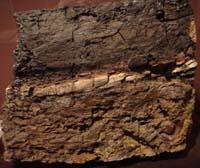Younger dinosaur fossil
2011/08/06 Galarraga Aiestaran, Ana - Elhuyar Zientzia
Now, fossil discoverers claim that their discovery reinforces the theory of shock. The fossil is a brown branch of a Triceratops or Torosaurus, 45 centimeters high, which has been discovered in Montana, 13 centimeters below the iridium layer indicating the impact of the asteroid.

In this photo the iridium layer is clearly seen. This layer is an indicator of the impact of the asteroid. (Photo: Eurico Zimbres)
Precisely this layer of iridium is the key to the theory of collision. It is a sediment of 65 million years ago, very special, since on Earth there is hardly any iridium. Alvarez, father and son, first realized it and said that their origin should be alien. For example, an asteroid hits the Earth, or... Later, on the Yucatán peninsula, traces of a huge impact have been found and over time more evidence has been found that the shock occurred.
Given the absence of dinosaur fossils above this layer of iridium (that is, for 65 million euros), Alvarez considers that the shock should be the cause of the loss of dinosaurs. This conviction was shared by Jan Smit and other prestigious geologists and paleontologists, who today is the most accepted theory.
The problem was that, at the time they proposed the theory, the youngest fossil dinosaurs found were found 3 meters below the layer. That is, between the final fossil and the shock there were 100,000 years. According to this, at the time of the crash there were no dinosaurs left on Earth.
In 1991, a fossil was discovered in New Mexico, 37 centimeters below the layer of images. The discovery reinforced the theory of shock, but it was not enough for the opponents of theory to change their minds. The current one is very close to the iridium layer, at 13 centimeters. Therefore, there is no doubt that when the asteroid hit the Earth there were still dinosaurs. In addition, researchers continue to excavate in the hope of finding more fossils.
Tesoro de Zumaia
It should be noted that one of the best known examples of the iridium layer, so useful for paleontologists, is found in Zumaia, on the cliffs of Itzurun. Paleontologists and geologists from all over the world come to investigate because it is very clear and clear and is in an accessible place. For scientists it is the indicator of the limit K/T, which marks the transition from Cretaceous to Tertiary.
In addition, in the cliffs of Itzurun there are other geologically important limitations. In fact, last year two international organizations, the International Committee on Stratigraphy (ICS) and the International Union of Geological Sciences (IUGS) declared a stratotype to two temporary limits. This means that they are referenced internationally to express the border between both eras.
Specifically, Daniense/Selandiarra and Selandiarra/Thanetiense are the temporary limits that are to be called stratotype. Both belong to the Paleocene. The first, D/S, dates from 61.1 million years ago; the most remarkable geological fact of the time is the spectacular descent of sea level. The second (S/T), for its part, was 58.7 million years ago and is important for the investment of the poles. Therefore, it is not surprising that Itzurun is the preferred place of Euskal Herria for researchers working in this field.
Published in Annex GAUR8.

Gai honi buruzko eduki gehiago
Elhuyarrek garatutako teknologia





